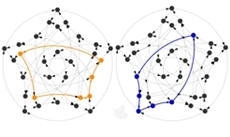Computing in the net of possibilities
23 Aug 2012
Scientists at the Max Planck Institute for Dynamics and Self-Organization in Göttingen have developed an entirely new principle for information processing. The complex network computer now stands as an alternative to the other possibilities in data processing - such as the conventional computer or the quantum computer.
 |
| In systems composed of coupled oscillating elements the saddle points form a network. The above networks belong to a system of five elements. The saddle points are depicted as points. Every saddle point is connected to four others: two of these connections lead to the particular saddle point, two others away from it. The figure shows two possible paths (orange and blue) the system may take. Each path corresponds to the result of a calculation. © MPI for Dynamics and Self-Organization |
The fundamental requirement is a system, for instance a laser, with oscillating elements that can interact with one another. The researchers were able to demonstrate that the characteristic dynamics of such a system can be cleverly harnessed to perform the full range of logical operations.
The complex network computer can even perform some tasks, such as the coarse sorting of numbers, considerably faster than conventional computers. Furthermore, the researchers have managed to take a first step in programming a robot according to the new principle.
A computer is much more than simply hardware. Foremost, it is a principle for the processing of data and information. The essence of the conventional computer for example, which has long had a decisive effect on our daily life, is not to be sought in transistors, chips and semiconductors.
Rather, it is characterised by the ways and means of performing calculations with the help of two easily distinguishable states (conventionally known as 0 and 1). Scientists at the Max Planck Institute for Dynamics and Self-Organization in Göttingen have now developed a completely new principle for information processing. Their so-called complex network computer is equally capable of performing arbitrary calculations, but does this under completely different conditions.
"In contrast to classical data processing on a PC, our new approach is not based on a binary system of zeros and ones", explains Marc Timme, head of the Network Dynamics research group at Institute. What is more, a complex network computer could in principle be built from any oscillating system. "The simplest example is a pendulum", says Timme.





.webp)

























